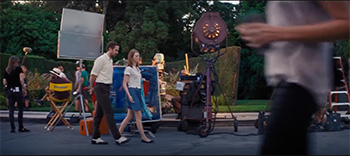Tip #1080: Filmmaking Fundamentals: Blocking
… for Random Weirdness
Tip #1080: Filmmaking Fundamentals: Blocking
Larry Jordan – LarryJordan.com
These five videos illustrate different ways to handle blocking a scene.


This article, written by Jourdan Aldredge, first appeared in PremiumBeat.com. This is a summary.
When watching amazing cinema, there are many aspects you’ll notice right away and often remember forever — great lines of dialogue, breathtaking action sequences, and beautiful cinematography. However, one film element that often gets ignored, but is still crucially important, is blocking.
Before we go into learning from the masters, let’s go over some of the basics of scene blocking. Scene blocking covers everything that has to do with placement and movement between characters, props, and camera(s) for every shot and scene. Unless you’re shooting a documentary or a certain type of improvised action, most film scenes are tightly controlled, blocked, and rehearsed so that every movement and action is accounted for.
Finally, the most important part of any scene blocking is the camera. In many ways, the camera — which represents your audience and POV — is the primary character in your scene. Consider your camera placement, its framing, and any (or all) movements that you might employ, from simple pans to complex tracking shots, when working on your scene blocking.
In this article, Jourdan provides videos illustrating:
- How to block a scene
- How Hitchcock blocks a scene in “Vertigo”
- How Scorsese blocked a scene in “The Wolf of Wall Street”
- How Akira Kurosawa using blocking
- How Kubrick, Spielberg and Inarritu blocked scenes
SUMMARY
When you’re finally shooting your scenes with your carefully defined blocking in action, it’s helpful to treat each shot and scene as its own mini-movie. You have your actors ready to go in their starting positions, you have your lights set and queued up for any adjustments, and your camera is rehearsed and ready to move. Once you call action, you’re really just recreating the stage play that you’ve blocked and mapped out — now it’s your job to shoot it to the best of your ability.


Leave a Reply
Want to join the discussion?Feel free to contribute!